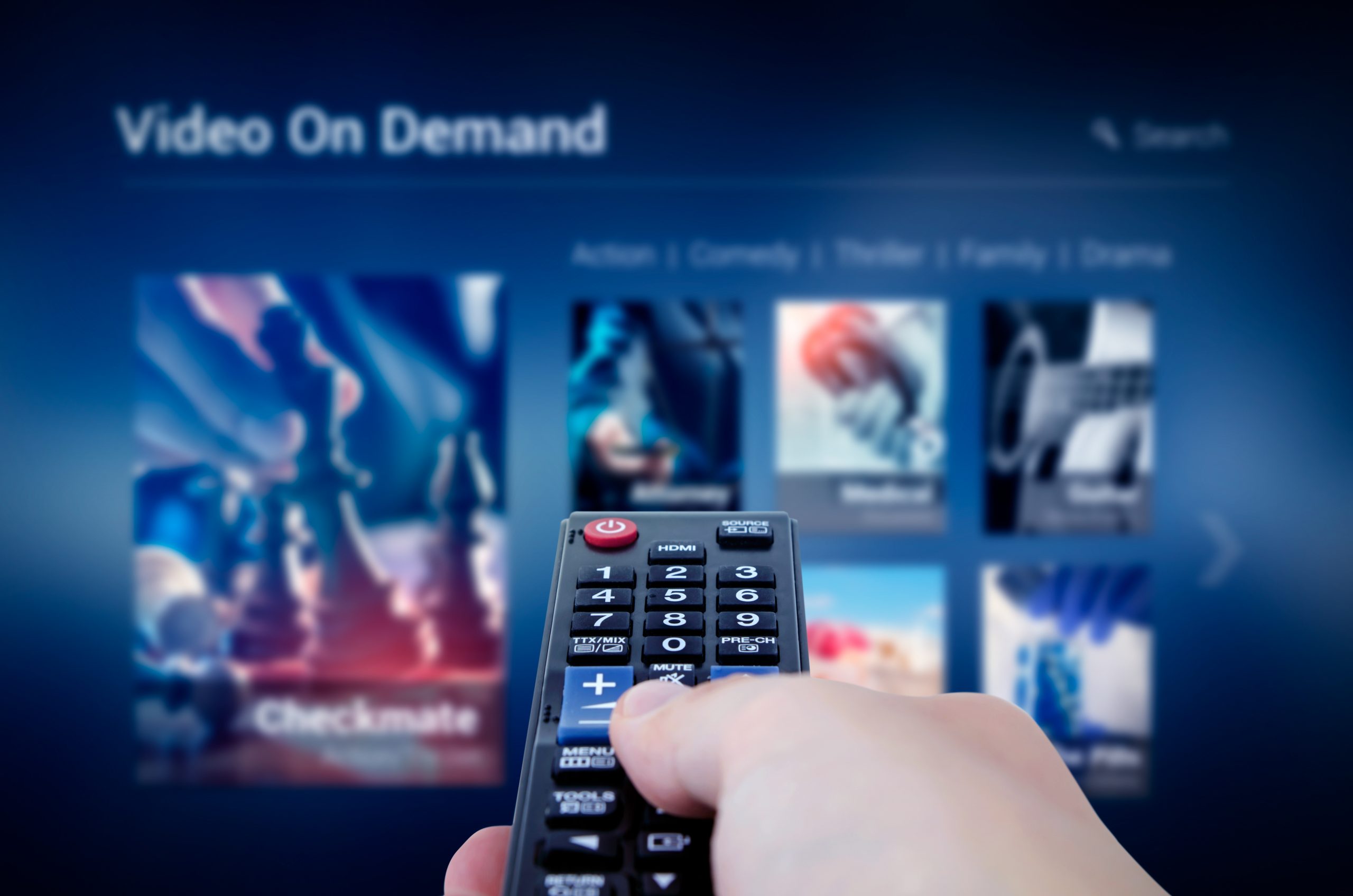VOD, AVOD, SVOD, TVOD: what are the possibilities today?
You have probably seen these acronyms, all related to online video: VOD, AVOD, SVOD, TVOD. What is behind these abbreviations? What is the state of the current market? Who are the players involved? These are the questions we will answer in this article. As you will see, the industry is in a state of turmoil, as the ongoing pandemic has amplified the demand for online entertainment.
What is VOD?
This is the founding abbreviation: “Video On Demand”.
You all know traditional television, revealed to the world in its cathodic version in 1926. This media, whose initial formula still exists through the PAF channel package, is consumed in continuous flow. If you want to watch a program, you have to be at the station at the given time, otherwise you’ll miss the beginning.
The first evolution, before the appearance of VOD, was to allow viewers to record programs or pause them, a real revolution at the time. This function appeared at the beginning of the 2000s on the boxes offered by cable television providers (you have to admit that VHS also made it possible to record programs as early as the 1980s, but the process was a little more restrictive).
Today, VOD is no longer limited to the television in the living room. We consume video content on all our fixed and mobile devices connected to the Internet, through a single account, accessible from several applications. This is what Anglo-Saxons call ATAWAD (Anytime, Anywhere, Any Device). In France, we talk about “mobiquity”. VOD can be consumed either only via internet (OTT, for “Over The Top”) or via cable.
Depending on the world of monetization, the VOD is completed with a prefix: A, S or T.
“A” for “advertising-based”. This is the VOD available in return for the display of advertisements.
“S” for subscription-based. This is VOD accessible through a subscription.
“T” for “Transactional”. This is VOD accessible in “pay-per-view” mode, on a pay-per-view basis. There are two variants of TVOD. The TVOD-DTR (Download To Rent), when you download a video for rental, for a period of 24 or 48 hours, like in the video club era, and the TVOD-EST (Electronic Sell-Through), when the video is available for permanent download, like buying a good old DVD. The availability of either option often depends on the release date and the granting of rights by territory.
Some players choose to distribute their content only via the Internet (OTT) without immediate monetization. This is the case, for example, of UEFA with its UEFA.TV offer, launched in 2020 in collaboration with the national leagues of the various European countries.
SVOD: the giants’ favorite battlefield
The SVOD, favored for the recurrence of its economic model, is the space where the giants of the sector confront each other. At the beginning of 2020, Netflix, world leader, had 167 million subscribers, followed by Amazon Prime Video (accessible to all Prime subscribers), with 150 million customers. On the third step of the podium, we find a content expert, Disney, with its Disney+ offer, which at the end of 2020 had nearly 74 million subscribers. Apple TV+ does not communicate on the number of subscribers, but it is estimated that they would be close to forty million internationally. HBO Max and Hulu are two other American brands you may have heard about.
In the third quarter of 2020, the overall annual growth of the SVOD market was 217.6 million users, compared to a previous record of 211.7 million in the fourth quarter of 2018. This new record can probably be partly explained by the containment imposed by the pandemic and the thundering success of Disney+. In the third quarter of 2020, there were a total of 769.8 million SVOD subscribers worldwide. We will therefore approach one billion next year!
In France, SVOD offerings include Canal+ Series, OCS and Salto, the SVOD platform of TF1, M6 and France TV launched on October 20, 2020.
Recently, Discovery Channel has embarked on the SVOD adventure through its Discovery+ offer, available in the United States at two rates: $4.99 per month with advertising and $6.99 per month without advertising. The deployment of Discovery+ is notably based on a partnership with the operator Verizon, which will offer its 55 million subscribers access to the formula without advertising at the price of the basic formula (4.99 instead of 6.99).
Note the interesting experimentation of Netflix in France which, like a traditional TV medium, now offers to consume a constant flow of programs, offered under the name Direct, so that you don’t have to waste time selecting a movie or series. The future will tell us if this experience will be extended.
TVOD: the home cinema club
TVOD is the preferred format for the most premium content, whose appeal allows monetization by title rather than inclusion in an “all inclusive” subscription offer.
This category includes iTunes Video, Canal VOD, Google Play, Microsoft Films & Series, Amazon Rent & Buy, Rakuten TV, etc. Let’s also mention for France ARTE TV and UniverCiné (which also offers SVOD).
AVOD: the format that goes from strength to strength
Given the challenge of converting trial packages to a premium subscription, some operators are opting for AVOD, financed by advertising, either as an exclusive monetization formula or as a complement to their paid SVOD offer. AVOD is also a possible extension of an Internet streaming TV offer, as demonstrated by the launch of MANGO by Molotov.tv.
In the United States, IMDBtv (owned by Amazon) has 40 million users of its AVOD offer. TUBI, a pure AVOD player, has 33 million users.
Youtube and Dailymotion can also be classified in the AVOD category, attracting 2 billion and 300 million users respectively.
The economic challenges of VOD
The market, as you will have understood, is very dynamic. Some will even go so far as to say that it is saturated. The pockets of the spectator not being infinitely expandable, the actors involved are fighting a fierce battle, through promotions, partnerships but especially through free trials without commitment.
The challenge is to convert these trials into long-term subscriptions. In three weeks Salto, for example, will have garnered 100,000 free subscriptions, a start comparable to that of Netflix launched in France in 2014. The question will be how many will switch to paid subscriptions.
The attractiveness of the content, constantly renewed, is of course a key factor in customer acquisition and retention (beyond the free trial and over the long term). The massive infatuation for Disney+ can be explained by the richness of its exclusive catalog. Netflix and Amazon are the new Hollywood, investing heavily in their productions. Alongside these big machines, however, there is a niche opportunity for more confidential content, presented in a coherent offer. One example is MUBI, active in the independent film market (10 million members).
Amazon and Apple TV+ are two striking examples of VOD offers exploited in addition to a historical activity: e-commerce for Amazon and the sale of devices for Apple. These VOD proposals reinforce the basic offer. Amazon Prime has undoubtedly benefited from the launch of its VOD offer for the acquisition of new Prime subscribers. These new subscribers perceive Amazon’s SVOD offer as “free”, offered as a “bundle” with the e-commerce delivery option.
The technical challenges of VOD
Today’s users expect to be able to consume the contents of their SVOD subscription or any AVOD / TVOD offer via all their devices: computer, television, tablet, smartphone.
On a computer, the experience often takes place through the browser (or via native applications on MacOS and Windows). On mobile platforms, an application is the preferred vector of content consumption. It is therefore necessary to develop and update a series of applications adapted to each device. Given the existence of two operating systems (iOS/Android), it is crucial to rely on tools that respond to the specificities of each device. This guarantees a smooth experience and therefore user satisfaction, which is essential for user retention.
As we will discuss in another article, the move to 5G will undoubtedly be a growth vector for mobile VOD consumption. We also analyze in this other article the continuity of the user experience from one device to another.


